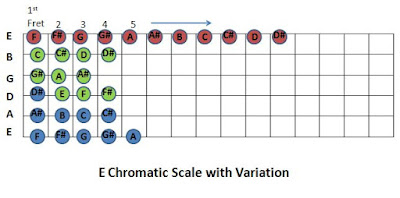Chromatic Scale Guitar Concept Learning
Chromatic Scale:
In this post we are going to learn all about Chromatic Scale and its variation and in short 'What is chromatic scale and how it has different variations for different Guitar Notes'.
Well Scale is a very deep subject so in this post we are going to cover Chromatic scale for guitar with all possible variations, which will give you a proper understanding of Scale. with the
Let's quickly start with the Chromatic Scale definition first.
What are Chromatic Scales on Guitar:
Chromatic Scale is a musical scale with 12 Notes, each a
distance above or below its adjacent note.
So basically Chromatic scale is a sequence of 12 notes as
per Music theory. Chromatic scale can be of any note e.g. C, C#, D, D#, E, F,
F#, A, A# & B Notes etc.
The first note in the scales defines the name of its
Chromatic Scale.
Suppose if Scale starts from C note then it is a C Chromatic
scale if it starts with A note then it’s a A Chromatic scale. So basically there are multiple Chromatic Scales you can play on Guitar.
C Chromatic Scale on Guitar :
As name suggests C chromatic scale starts from C note and
reaches to the next 11 notes.
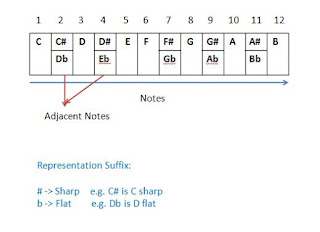 |
| Fig. Chromatic Scale C |
In the above picture scale starts from C note then C sharp
then D and so on and the last note is B note.
Points to Remember:
1.
C# (C sharp) and Db (D flat) are same notes.
Similarly other notes like D# and Eb are same and so on.
2.
There is always no gap between B and C notes and
E F notes.
3.
Other notes like C and D or F & G or A and B
have adjacent notes known by (Sharp or flat)
A Chromatic Scale on Guitar:
Same as C chromatic scale as name suggests A chromatic scale
starts from A note and reaches to the next other 11 sequential notes.
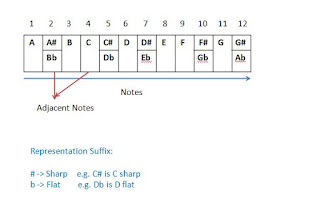 |
| Fig. Chromatic Scale A |
In the above picture scale starts from A note then A sharp
or B flat then B and so on and the last note is G# note.
What is Pitch in Guitar in Chromatic Scale:
Sound of a same note on an Octave higher or lower is known
as Pitch of that particular note.
Let’s take an example of C note in B string. Basically there
are 2 places in B string where we can play C note. Both the octave will sound
same however Pitch will be always different.
 |
| Fig. Pitch C in Chromatic Scale |
That concludes there is no difference in sound, only
difference in their Pitch.
Playing C note at 13th fret pitch will sound at
higher Pitch in comparison with the C note at first fret.
Also, pitch level always increases from left to right (Lower
fret to higher fret).
Let’s explore Guitar Pitch in detail:
What is Pitch Variation in Guitar?
Pitch Variation is about having different pitch with same
sound of same note at different position in Fret board/ fingerboard.
 |
| Fig. Chromatic Scale Pitch variation C Note |
Till now we have looked into pitch of notes C on string B,
let's check it on string D now.
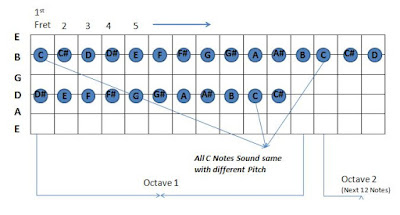 |
| Fig. Chromatic Scale Pitch variation C Note with different octave |
Look at the picture, you'll notice that note C is also
available on string D. And the fact is it is available in all the 6 strings.
Also, if we are going to play note C in all relevant frets and string, we will
be getting same sound, only Pitch will differ.
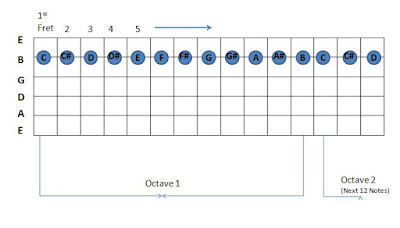 |
| Fig. Chromatic Scale Pitch variation C Note in different Octave |
Look at the picture Octave 1 is having 12 frets and Octave 2
will cover another 12.
C note in Octave 1 have lower pitch than octave 2.
Octave 1 is a complete C Chromatic scale. Also, every octave
which is a set of 12 notes is a complete Chromatic scale. In case any octave of
12 notes starts from E note will be defined as E Chromatic scale.
E Chromatic Scale on Guitar:
In the beginning we always use E chromatic scale to start learning
scales.
Let’s look into the chromatic scale.
In this E chromatic scale as we already have E open string
as E note so we can start from open E string itself.
 |
| Fig. Chromatic Scale E Note |
Now coming to the variation of E chromatic scale as above
picture is just to give you a glimpse about scale in a straight line,
It is not important that we have chromatic scale in a
straight line. Now let’s merge the available notes from the straight line with
the open string positions to get the Chromatic scale variation.
Now we will play A as an open chord so as to break the
straight line sequence and to get the variation.
Same we will do when D notes comes, we will break the
sequence and play D note as an open string available just above A string.
Now it looks cool in term of playing complete E chromatic
scale (with blue circles) with meaningful variation.
Let’s discuss the procedure to play this E Chromatic scale,
1.
E Note Open
2.
F Note
3.
F# Note
4.
G Note
5.
G# Note
6.
A Note
7.
A# Note
8.
B Note
9.
C Note
10.
C# Note
11.
D Note
12.
D# Note
We are not going to stop after completion of first Octave (first
E chromatic Scale), let's keep doing it to get another E chromatic scale at
different position.
By looking at the above picture we can conclude that the
second pair of E chromatic scale starts right next to the first one. It starts
from String D fret 2 to String B fret 4.
Similarly, the third E chromatic scale starts from thin E
string, first note will be open E, then by pressing E string in first fret we
get note F and so on. You can play this third E chromatic scale in a straight
line (All continuous 12 notes in E string).
So basically we have discussed E chromatic scale in three
different positions or pairs.
First E chromatic scale is the combination of blue circles and
E, A and D open notes. Second pair of chromatic scale is a combination of green
circles and G and B Open notes. Third pair of E chromatic scale is a combination of red circles and
E open string.
Fourth pair is also possible (Previously discussed) on the
thick E string.
Let’s summarize things we learn in this lesson.
Things to Remember on Chromatic scale:
1. Using this method you can play Chromatic scales for any
note such as A Chromatic scale, A# Chromatic scale, B Chromatic Scale, C
Chromatic scale, C# chromatic scale, D, D#, E, F, F#, G & G# Chromatic
scale.
2. An Octave contains 12 Notes.
3. Any Octave is a chromatic scale
4. First note of any Octave (12 Notes) decides the name of
chromatic scale. E.g. If Octave starts from F# (F Sharp) then it is a F# Chromatic
scale.
5. Pitch increases as you move higher on Frets (Left to
right for right handed guitarist).
6. Pitch decreases as you move lower on the Frets (Right to left
for right handed guitarist).
7. If you are playing on the higher octave that means you are
playing Chromatic scale on higher pitch and vice versa.
8. We can play multiple Chromatic scales for same note but
remember all scales are in different octave and so will have different
pitch but same sound.
Hope this lesson on all chromatic scales will clear the
complete picture of all Chromatic Scale on Guitar.
Have lots of things to share, Stay in touch!!!
Happy Chromatic Scale on Guitar Learning!!!


